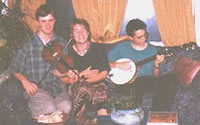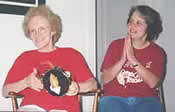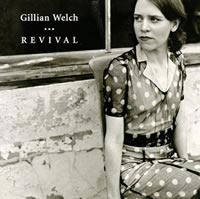When Alan Lomax died in July, 2002 at the age of 87, nearly every obituary mentioned the O Brother, Where Art Thou? soundtrack, which includes both a recording by Lomax and a song he arranged. I find it fitting that Lomax’s epitaphs tie him directly to this platinum-selling package of roots music. Both Lomax’s work and the O Brother soundtrack have exposed time-tested music to contemporary audiences. Both have inspired a horde of imitators. And both inspire my simultaneous respect and resentment.
Lomax’s noble impulse to preserve and present vernacular music was long intertwined with his desire to popularize and profit from it. Alan Lomax and his father, John, co-wrote several books aimed at popular rather than academic audiences, combining the lyrics they compiled from their field recordings and the capsule histories of the songs and performers. Those books, and the Library of Congress-published field recording series overseen and edited by Alan Lomax, by then the Assistant in Charge of its Archive of American Folk Song, are important milestones in the study of American folk music. At the same time, the Lomaxes’ copyrighted arrangements of traditional songs, their not-always-adequate compensation to performers (yes, I know they recently paid royalties to James Carter, leader of a group of Mississippi prisoners singing “Po’ Lazarus‚” but why did it take over forty years to find him?), and their tendency toward condescension of the very traditions they documented (Leadbelly made to perform in striped prison garb), can be viewed as exploitative.
O Brother, Where Art Thou?, for those who have missed the hoopla of the past two years or so, is a musical comedy and adaptation of The Odyssey, set in the Depression-era South against a soundscape of old-time music. The Coen Brothers’ film pays clever homage to Preston Sturges’s Sullivan’s Travels, borrowing its title from Sturges’s unrealized film-within-the-film. The Lomaxes journeyed in search of authentic music; Sullivan traveled as a hobo to experience suffering; Ulysses Everett McGill’s odyssey turned toward home and family. The O Brothersoundtrack, readily available at your local record store, offers one-stop shopping for ballads, blues, gospel, and country music, although it’s often referred to as a “bluegrass” album (perhaps because some of its performances feature bluegrass musicians).
In the soundtrack’s liner notes, Ethan Coen refers to the music as “harking back to a time when music was a part of everyday life and not something performed by celebrities. That folk aspect of the music both accounts for its vitality and makes it fold naturally into our story without feeling forced or theatrical.” He’s right about the vitality part—O Brother’s sales figures and Grammy awards prove that an audience is hungry for this music—but I wonder if he regrets that line about celebrities. The soundtrack’s surprising success has made household names of its performers, and the new fans, proud to have discovered this music “without the benefit of radio play” (it has, however, received ample coverage on public radio), nonetheless miss the point by being brand-loyal to the O Brother package.
My own voyage of discovery into old-time music occurred long after the era of the Lomax type of “songcatcher” and a folk revival or two. In the mid–1990s, I found myself interning in the Archive of Folk Culture at the Library of Congress in Washington, D.C. along with a group of like-minded teen- and twenty-something American Studies and History majors, helping to preserve, file, and produce reference aids for the sound recordings and associated documentation created by the Lomaxes and others throughout a century of field recording. We worked under the direction of Joe Hickerson, a guitarist, singer, and figure of the 1950s-60s “folk boom,” who had worked in the Archive since 1963 and had an uncanny memory for all things associated with traditional music and its popularized forms. The director of the American Folklife Center (which includes the Archive of Folk Culture), Alan Jabbour, had recorded a number of Appalachian fiddlers in the 1960s and 1970s and had been prominent in that era’s resurgence of old-time string band music as a fiddler in the North Carolina-based Hollow Rock String Band.
I was a recent college graduate with broad-ranging musical tastes, a family background in West Virginia instrumental and vocal musical traditions, and a historian’s urge to trace things back to their roots. Many other interns were still in school, getting college credit for the internship while scratching similar cultural and historical itches. One, Sara Zoë Patterson of Hudson, New York, was a died-in-the-wool Pete Seeger and Woody Guthrie fan who, like Pete, had dropped out of college after one semester and, like Woody, began traveling the country gathering life experiences: she was a canoeing instructor, organic farmer, and Division III college football manager in the years following her archival internship.

The internship was unpaid, so most of us had service industry jobs to sustain us while spending normal office hours working in the Archive. This made it difficult to coordinate schedules for after-hours socializing, but somehow it worked out that we were all free on Tuesday nights. Sara Zoë rented a room in a centrally-located house shared with students and interns of various other Washington non-profits, at 1628 15th Street Northwest, to which she invited the crew from the Archive. She planned a main course and asked that guests bring something else to eat or drink. “And don’t forget your instruments!” Thus was born the Tuesday “1628” tradition.
The low-key, participatory nature of the gathering soon attracted a larger following. Joe Hickerson and Alan Jabbour, eager to pass on tunes and tales to the next generation, made appearances, as did other Folklife Center employees, volunteers, and their respective friends. The college students invited others from their American Studies classes. The other residents of 1628, rather than fleeing their home at the first squeak of a fiddle, stuck around on Tuesday nights and even invited their friends—Young Republicans, environmental activists, and skateboarders among them. Reflecting on her housemates’ reactions to the gatherings, Sara Zoë recalls, “It struck me how universal making music live can be—a lot of that music would’ve turned them off in recorded form, but not only did they participate, they invited their friends.” Months later, en route to the Appalachian String Band Festival in Clifftop, West Virginia, a Cuban-American Florida native who lived at 1628 admitted that he’d never been camping, never seen mountains, and “never hung out with so many Anglos”—yet he was drawn there by something about the music, and the coziness of the scene that developed around it.

Each participant contributed something to the mix, in addition to the requisite 6-pack or side dish, because even those unable to play an instrument joined in the sing-along, tossed out requests, or banged a spoon against a bottle for what became our rousing finale, “There Ain’t No Grave.” There was no audience, which meant that there could be no star performers. The songs were the stars.
Building on the lessons of our internship, we began recording the gatherings. There is as much, if not more, conversation on the tapes as there is music. Conversations tended to kick off with the stories surrounding the songs: where and from whom they were learned, leading off onto tangents about musical influences and variant lyrics, tunes or titles, and emotional reactions upon first hearings of the piece. The next time that a song was played, we could add our shared experience to its historiography. We copied the tapes and passed them on to friends who had moved out of town, further disseminating the group’s evolving understanding of traditional music and strengthening our ties to one another.
In the 1930s, the Lomaxes thought they had to capture the old songs and tunes before they were gone, smothered by popular culture. In the years following the 1952 Folkways release of Harry Smith’s Anthology of American Folk Music, fans sought out the performers featured in its decades-old recordings and brought them into the spotlight, some making a living playing music for the first time just before they died. In the 1990s, American folk music was again at a crossroads, turning up more and more often in unexpected places. We were not averse to the mass-mediated representations. In fact, we wished for more of them. We delighted in the re-release of the Anthology, the unpublished Woody Guthrie lyrics put to music by Billy Bragg and Wilco, and the mentions of fiddle tunes in Charles Frazier’s best-selling novel Cold Mountain. (Although after the release of the book’s companion CD, a fiddle-playing friend noted the crowds at Tim O’Brien and Dirk Powell’s performance at the Mt. Airy, North Carolina music festival, and sighed, “We’re rock stars now.”)

The shared homemade food and music created a social space that included discussion and dissection of books, films, and other cultural events. We swapped recordings, sharing discoveries old and new. Gillian Welch’s first release, presciently named Revival, contributed a new set of staples to our Tuesday night repertory, such as “By the Mark.” We bought techno composer and musician Moby’s Play album for the sampled Lomax field recordings. We went to the theater to see Wag the Dog for its archival recording sub-plot and The Apostle for its gospel soundtrack and cameo by June Carter Cash. We screened the video of John Sayles’s Matewan to pick out West Virginia musicians now known to us from the festival scene. When we read that a new Coen Brothers film would feature the music of Ralph Stanley and others we revered, we were thrilled.
There was a delicate balance between finding our interests increasingly reflected in pop culture, and finding it “down by the old mainstream,” to quote alternative country supergroup Golden Smog. O Brother tipped those scales. The film itself posed problems. Other Coen Brothers’ films tackle a given cultural milieu (earnest Midwesterners in Fargo; L.A. slackers in The Big Lebowski) with humor and ingenuity, or so I thought, as a cultural outsider. It was harder for me to laugh at stereotyped Southerners. Having grinned and borne countless mocking references to West Virginia (where I was born) and Kentucky (where I also have roots) over my lifetime, the 1628 experience had refashioned that region as a wellspring of musical heritage, and a source of pride. I didn’t like seeing the same old caricatures of yokels and Klansmen played out against banjos and fiddles.
For us, the music had been a collective experience, which made it meaningful. O Brother and its offshoots are a collective experience in that they‘ve sold millions of copies, but the sense of traditional music as being organic—a living, breathing, force drawing people together—seems to get a bit lost in the O Brotherpackaging. Though the film’s soundtrack features expertly produced, exquisite performances by some of my favorite interpreters of the old-time singing styles, its ubiquity had made it too iconic, too set in its ways. I’ll admit, I attended one of the Down from the Mountain concerts, but it seemed scripted and rote. The performers mostly play the songs in the same order in which they appear on the soundtrack. When the audience was asked to join in, on “Amazing Grace,” lined out by Ralph Stanley, the crowd didn’t seem to understand at first what was being asked of it—maybe because that song isn’t on the CD. But at the moment when, finally, thousands of voices echoed Ralph’s frail tenor, I finally felt that sense of communal musical space that had been lacking throughout the concert. I can only hope that someone in the crowd somewhere felt the power of that moment and decided to hold a dinner party, with instruments.
Next Essay (link to Nelson article)
Works Cited
Frazier, Charles. Cold Mountain. New York: Atlantic Monthly Press, 1997.
Oermann, Robert K. Liner notes. O Brother, Where Art Thou? Mercury, 2000.
Discography
Billy Bragg and Wilco. Mermaid Avenue. Elektra, 1998.
—. Mermaid Avenue Vol. II. Elektra, 2000.
Golden Smog. Down by the Old Mainstream. Rykodisc, 1995.
O Brother, Where Art Thou? Mercury, 2000.
Moby. Play. Rave New World, 1999.
Powell, Dirk, Tim O’Brien, and John Herrmann. Songs from the Mountain. Howdy Skies Records, 1998.
Smith, Harry. Anthology of American Folk Music. Smithsonian Folkways, 1997.
Welch, Gillian. Revival. Almo Sounds, 1996.
